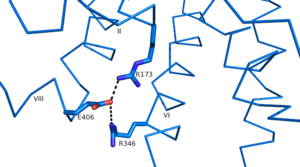Sandbox Reserved 1167
From Proteopedia
(Difference between revisions)
| Line 7: | Line 7: | ||
== Background == | == Background == | ||
| - | [[Image:7tm_labeled_with_membrane.png|200 px|left|thumb|The 7tm spans the cell membrane]] | + | [[Image:7tm_labeled_with_membrane.png|200 px|left|thumb|The 7tm spans the cell membrane]]The human glucagon receptor (GCGR) is one of 15 secretin-like, or Class B, G-protein-coupled receptors (GPCRs). Like other GPCRs, it has a <scene name='72/721538/7tm_labeled_helicies/3'>7 trans-membrane </scene> helical domain (shown in blue) and a globular N-terminus <scene name='72/721538/Ecd/2'>extracellular domain</scene> (shown in magenta). As its name suggests, the 7tm is made up of alpha helices that pass through the membrane seven times. The extracellular domain has an α-β-β structure that consists of two antiparallel β-sheets and a N-terminal α-helix<ref>PMID:26227798</ref>. |
| - | The human glucagon receptor (GCGR) is one of 15 secretin-like, or Class B, G-protein-coupled receptors (GPCRs). Like other GPCRs, it has a <scene name='72/721538/7tm_labeled_helicies/3'>7 trans-membrane </scene> helical domain (shown in blue) and a globular N-terminus <scene name='72/721538/Ecd/2'>extracellular domain</scene> (shown in magenta). As its name suggests, the 7tm is made up of alpha helices that pass through the membrane seven times. The extracellular domain has an α-β-β structure that consists of two antiparallel β-sheets and a N-terminal α-helix<ref>PMID:26227798</ref>. | + | |
| Line 56: | Line 55: | ||
== Clinical Relevance == | == Clinical Relevance == | ||
| - | Because of | + | Because of GCGR's role in glucose homeostasis, it is a potential drug target for Type 2 diabetes. Specifically, molecules that antagoinze the glucagon receptor may be able to lower blood sugar levels. Studies have shown that two antibodies, mAb1 and mAb23, target the ECD domain of the GCGR interrupt glucagon binding<ref>PMID:22908259</ref>. Disrupting the normal interactions between the ECD and the 7tm domains, these antibiotics inhibit the receptor's function and help to lower blood glucose level. Additional research has shown that another antibody, mAb7, inhibits GCGR allosterically<ref>PMID:24189067</ref>. Binding to a site outside of the binding pocket, mAb7 inhibits the receptor without interacting with essential glucagon binding residues. |
</StructureSection> | </StructureSection> | ||
Revision as of 04:22, 30 March 2016
| This Sandbox is Reserved from Jan 11 through August 12, 2016 for use in the course CH462 Central Metabolism taught by R. Jeremy Johnson at the Butler University, Indianapolis, USA. This reservation includes Sandbox Reserved 1160 through Sandbox Reserved 1184. |
To get started:
More help: Help:Editing |
Class B Human Glucagon G-Protein Coupled Receptor
References
- ↑ Hanson, R. M., Prilusky, J., Renjian, Z., Nakane, T. and Sussman, J. L. (2013), JSmol and the Next-Generation Web-Based Representation of 3D Molecular Structure as Applied to Proteopedia. Isr. J. Chem., 53:207-216. doi:http://dx.doi.org/10.1002/ijch.201300024
- ↑ Herraez A. Biomolecules in the computer: Jmol to the rescue. Biochem Mol Biol Educ. 2006 Jul;34(4):255-61. doi: 10.1002/bmb.2006.494034042644. PMID:21638687 doi:10.1002/bmb.2006.494034042644
- ↑ Yang L, Yang D, de Graaf C, Moeller A, West GM, Dharmarajan V, Wang C, Siu FY, Song G, Reedtz-Runge S, Pascal BD, Wu B, Potter CS, Zhou H, Griffin PR, Carragher B, Yang H, Wang MW, Stevens RC, Jiang H. Conformational states of the full-length glucagon receptor. Nat Commun. 2015 Jul 31;6:7859. doi: 10.1038/ncomms8859. PMID:26227798 doi:http://dx.doi.org/10.1038/ncomms8859
- ↑ Lotfy M, Kalasz H, Szalai G, Singh J, Adeghate E. Recent Progress in the Use of Glucagon and Glucagon Receptor Antago-nists in the Treatment of Diabetes Mellitus. Open Med Chem J. 2014 Dec 31;8:28-35. doi: 10.2174/1874104501408010028., eCollection 2014. PMID:25674162 doi:http://dx.doi.org/10.2174/1874104501408010028
- ↑ Koth CM, Murray JM, Mukund S, Madjidi A, Minn A, Clarke HJ, Wong T, Chiang V, Luis E, Estevez A, Rondon J, Zhang Y, Hotzel I, Allan BB. Molecular basis for negative regulation of the glucagon receptor. Proc Natl Acad Sci U S A. 2012 Sep 4;109(36):14393-8. Epub 2012 Aug 20. PMID:22908259 doi:http://dx.doi.org/10.1073/pnas.1206734109
- ↑ Mukund S, Shang Y, Clarke HJ, Madjidi A, Corn JE, Kates L, Kolumam G, Chiang V, Luis E, Murray J, Zhang Y, Hotzel I, Koth CM, Allan BB. Inhibitory mechanism of an allosteric antibody targeting the glucagon receptor. J Biol Chem. 2013 Nov 4. PMID:24189067 doi:http://dx.doi.org/10.1074/jbc.M113.496984

